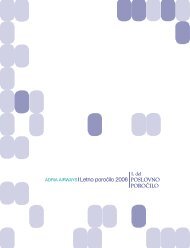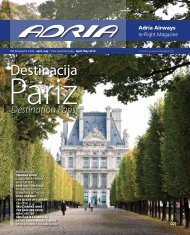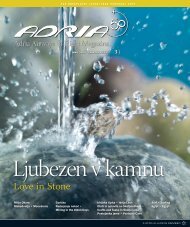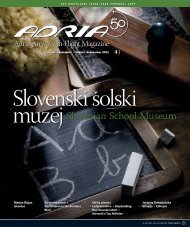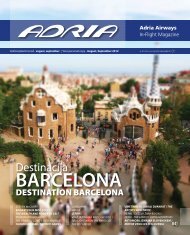You also want an ePaper? Increase the reach of your titles
YUMPU automatically turns print PDFs into web optimized ePapers that Google loves.
UMETNOST IN KULTURA / ART & CULTURE<br />
Umetnostna galerija Maribor, do 24. februarja <strong>2013</strong><br />
SKORAJ POMLAD<br />
100 let slovenske umetnosti<br />
Umetnostna galerija Maribor v sodelovanju z osrednjimi slovenskimi<br />
galerijami in muzeji predstavlja ob zaključku Evropske prestolnice<br />
kulture Maribor 2012 pregled likovne umetnosti XX. stoletja – od<br />
impresionistov do retroavantgardistov – ter odpira poglede na nove<br />
prakse slovenskih vizualnih umetnikov XXI. stoletja.<br />
100 let slovenske umetnosti je razdeljenih na dva dela: na XX. in XXI.<br />
stoletje. XX. stoletje sledi kronološkemu pregledu slovenske umetnosti<br />
od impresionistov do konca stoletja. Med gostujočimi muzeji<br />
in galerijami zastopa osrednjo mesto Moderna galerija z velikimi<br />
imeni, kot so Marij Pregelj, Gabrijel Stupica in Zoran Mušič. Druge<br />
zbirke prepoznavamo po odličnih segmentih slovenske umetnosti,<br />
kot na primer Narodno galerijo s predstavniki slovenskega impresionizma<br />
Rihardom Jakopičem, Matijo Jamo, Ivanom Groharjem<br />
in Matijo Sternenom, Obalne galerije z umetnostjo 80-ih, Galerijo<br />
Miklova hiša s kiparstvom s konca stoletja ter zbirko Akademije za<br />
likovno umetnost in oblikovanje z deli njenih profesorjev. Razstava v<br />
UGM tako v enem prostoru združuje dela, ki običajno niso razstavljena<br />
skupaj in v novih konstelacijah omogočajo sveže polje diskusij.<br />
Ob kronološkem pregledu razkriva razstava izbrane posebnosti:<br />
soba, namenjena izbranim tematskim poudarkom, ki se bodo tekom<br />
razstave spreminjali, je v začetni postavitvi t.i. Mariborska soba.<br />
XXI. stoletje izpostavlja najzanimivejša imena sodobne umetniške<br />
produkcije. To so imena, ki puščajo za seboj sledi in katerih dela<br />
so že del zgodovine slovenske umetnosti, čeprav so jasno uprta v<br />
prihodnost: od umetnikov srednje generacije, Vadima Fiškina, Nike<br />
Špan in Nataše Prosenc, do mlajših vzhajajočih zvezd, Jasmine Cibic,<br />
Jaše, Petra Koštruna in drugih.<br />
Izmed mnogih pomenov pomladi je najmočnejša med njimi<br />
obljuba pričakovanja. Prastar zapis večnega nadaljevanja in prihoda<br />
ponovnega začetka. Kljub negotovosti nas prav pričakovanje požene<br />
na še tako negotovo pot.<br />
Maribor Art Gallery, until 24 <strong>Februar</strong>y <strong>2013</strong><br />
ALMOST SPRING<br />
100 Years of Slovenian Art<br />
In the final stage of the European Capital of Culture Maribor 2012, the<br />
Maribor Art Gallery (UGM), in cooperation with the major Slovenian galleries<br />
and museums, presents an overview of 20 th century art from Impressionism<br />
to Retro Avant-garde, offering insight into the new practices of<br />
Slovenian visual artists of the 21 st century.<br />
One hundred years of Slovenian art have been divided into two parts: the<br />
20 th and the 21 st century. The 20 th century follows a chronological overview of<br />
Slovenian art, starting with the Impressionists and continuing all the way to<br />
the end of the century. Among the participating museums and galleries, the<br />
Museum of Modern Art has the central role with its contribution of the works<br />
by several great names such as Marij Pregelj, Gabrijel Stupica and Zoran Mušič.<br />
Other collections can be recognised by their excellent segments of Slovenian<br />
art, for instance the National Gallery with the representatives of Slovenian<br />
Impressionism: Rihard Jakopič, Matija Jama, Ivan Grohar and Matija Sternen;<br />
Coastal Galleries Piran with 1980s art, Gallery Mikl house with the sculptures<br />
from the end of the century and the collection of the Academy of Fine Arts and<br />
Design with works by its academic staff. The UGM exhibition joins works that<br />
normally are not displayed together and by positioning them in new constellations,<br />
a fresh discourse is enabled. Apart from the chronological overview,<br />
the exhibition reveals certain special features – a room is reserved for selected<br />
thematic emphases that will change in the course of the exhibition: initially,<br />
it is called the “Maribor room”. The 21 st century presents the most interesting<br />
names of contemporary art production. These are the individuals who have<br />
already made an impact and whose works have found their place in the<br />
history of Slovenian art, even though they are clearly focused on the future:<br />
ranging from the middle-aged generation (Vadim Fishkin, Nika Špan and<br />
Nataša Prosenc) to the younger artists, the “rising stars” (Jasmina Cibic, Jaša,<br />
Peter Koštrun and others). The strongest of the many connotations of spring<br />
is the promise of expectation. It is an ancient record of endless continuation<br />
and the arrival of a new beginning. It is precisely our expectations that drive us<br />
forward, no matter how uncertain the path ahead may be.<br />
Ljubljana Exhibition and Convention Centre, 15 <strong>Februar</strong>y – 12 May <strong>2013</strong><br />
Da Vinci - The Genius<br />
On 15 <strong>Februar</strong>y, the Ljubljana Exhibition and Convention Centre will open its doors to the biggest international<br />
travelling exhibition called Da Vinci – The Genius, which has already been seen over six years by millions of people<br />
in more than 40 cities around the world, from Rio de Janeiro and Tokyo to San Francisco and Moscow. The world’s<br />
biggest Da Vinci exhibition features over 200 fascinating, interactive and educational exhibits.<br />
Italian craftsmen have used Leonardo da Vinci’s manuscripts to make thorough and interactive life-size mechanical<br />
inventions. These include the first designs of a car, a bicycle, a helicopter, a glider, an aqualung, a submarine, a<br />
military tank and an ideal city, to name just a few. The exhibition contains much more than just inventions, though.<br />
There are reproductions of Leonardo’s most famous designs, anatomical studies, drawings of the famous fresco The<br />
Battle of Anghiari and other Renaissance art available for viewing on large interactive screens.<br />
The latest addition to the exhibition is the reconstruction of The Last Supper in high resolution (8.9 m x 4.5 m). This impressive<br />
screen ingeniously supplements the existing 3D animations. The detailed analysis of the huge horse statue (Sforza Horse)<br />
and the drawing of the Vitruvian Man are just a small part of the presentation of the Renaissance artist. The exhibition also<br />
reveals the secrets of Mona Lisa – a unique analysis of the iconic painting that was carried out at the Louvre Museum by the<br />
renowned scientific engineer, expert and fine art photographer Pascal Cotte.<br />
The exhibition is suitable for all age groups and is particularly recommended for families and schools.<br />
www.gr-sejem.si/obiscite-nas/koledar-prireditev<br />
23








